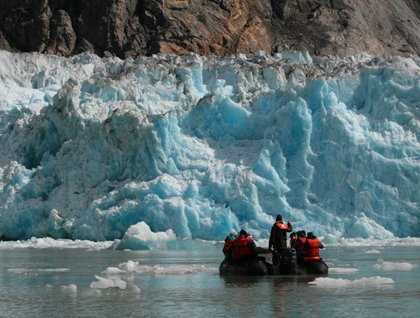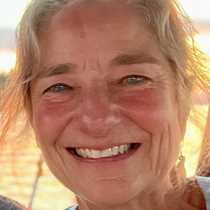Today we explored Tracy Arm, a narrow, bending fjord that cuts 32 miles into the coastal mountains. Early morning fog turned to thin wisps of clouds that seemed to stick to the tree-covered hills.
Two wilderness rangers joined us for breakfast. They told us about their work educating visitors and monitoring impacts on wildlife, all done while camping and kayaking in a vast wilderness. They spoke about the Wilderness Act, which is now 50 years old. In 1880, John Muir called this place a “wild, unfinished Yosemite.” The description still fits.
As we traveled up the fjord, the forest thinned, and trees eventually became scarce. Three-thousand-foot-high rock domes had little more than lichens and mosses on them, and waterfalls fed by ice fields tumbled down their rock faces.
South Sawyer Glacier came into view and skies cleared. We spent the rest of the morning watching the glacier from our small boats. It sounded like thunder as it shifted, and we watched its icy blue and white face expectantly. When blocks of ice fell, we paid close attention, and we were very fortunate to see some large calvings. Enormous ice blocks seemed to fall in slow motion, and caused waves, which soon softened into gentle swells. We watched in wonder as the glacier dropped multi-ton pieces of itself into the sea.
Harbor seals didn’t seem bothered by the waves and thunderous glacier sounds. Many of them rested on floating pieces of ice. Seals that were swimming surfaced, breathed and observed us, before they slipped back into the gray-green water.
In the afternoon the ship moved a bit, and we experienced the fantastic landscape via even smaller vessels: kayaks. We were free to touch the majestic walls of rock, paddle near small pieces of ice, investigate, or simply enjoy the dramatic surroundings. Some of looked at this section of fjord from a small inflatable boat. A sense of scale is so difficult to grasp here, but seeing kayakers with this incredible backdrop was a helpful reminder of just how tiny we humans really are.







